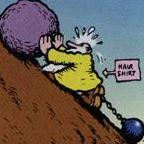Mike_B20
Posts: 389
Joined: 2/13/2003
From: Sydney, Australia
Status: offline

|
[QUOTE]Originally posted by cap_and_gown
[B]From my reading of Bergerud, the Zero was the premier dogfighter of WWII--highly manuverable at low to medium speed and with a good climb rate. If an allied plane tried to take on a zero one-on-one in a dog fight it was in a bad way. The problem for the japanese is the allies quickly figured this out and they did not dogfight zeros--they tried to gain a height advantage then dove through the jap concentration. They would then try to climb to gain an altitude advantage and repeat the process. So the allies quickly compensated for less manuverable planes at medium to low speed by taking advantage of their supperior diving ability.
In addition, the allies were taught to never fly alone. They always tried to have a wing man. The japs on the other hand did not fly in any particular formations and when a fur ball started they were more or less on their own.
Superior tactics and teamwork, then, even from relatively green pilots made up for inferior planes, such as the P-40 and F4F. Even the supposedly supperior P-38 and F4U would have been at a disadvantage if they had tried to dog fight a zero. The point, is, however, that they didn't. They used the plane's strengths, strengths the zero could not match.
So how do you factor in pilot skill into a situation where it is not simply the skill of a single allied pilot against single jap pilot, but instead, an allied pilot and his wingman who are trained to fight in ways that play to the strengths of their planes? Do you rate the planes as supperior because of the tactics they can effective employ? Or do you rate the pilots as supperior because of the training they are given on ways of dealing with zeros? IMO, it is six-of-one, half-dozen-the-other. [/B][/QUOTE]
There is an interesting write-up on the marine squadrons based at Guadalcanal,
http://www.ibiblio.org/hyperwar/USMC/USMC-C-Aces/index.html
Quoting from that site,
"Before the big mission on 23 October, the Coach had told his pilots, "When you see Zeros, dogfight 'em!" His instructions went against the warnings that most of American fighter pilots had been given about the lithe little Japanese fighter. Joe Foss' success on this day seemed to vindicate Bauer, however. Twenty Zeros and two Bettys, including the four Zeros claimed by Foss, went down in front of Marine Wildcats.
Up to this time the Zero was considered the best fighter in the Pacific. This belief stemmed from the fact that the Zero had spectacular characteristics of performance in both maneuverability, rate of climb, and radius of action, all first noted at the Battles of the Coral Sea and Midway. And it was because of its performances in these actions that it achieved the seeming invincibility that it did. At the same time, the Zero was highly flammable because it lacked armor plate in any form in its design and also because it had no self-sealing fuel tanks, such as existed in U.S. aircraft. Initially in the war, in the hands of a good pilot, the Zero could usually take care of itself against its heavier and tougher American opponents, but early in the air battles over Guadalcanal, its days of supremacy became numbered. By the end of the war in the Pacific, the kill ratio of U.S. planes over Japanese aircraft went from approximately 2.5:1 to better than 10:1.
".
Apparently, by this time the Japanese had lost a lot of their more skilled pilots and the US marines were at an advantage in a dogfight.
_____________________________
Never give up, never surrender
|
 Printable Version
Printable Version












 New Messages
New Messages No New Messages
No New Messages Hot Topic w/ New Messages
Hot Topic w/ New Messages Hot Topic w/o New Messages
Hot Topic w/o New Messages Locked w/ New Messages
Locked w/ New Messages Locked w/o New Messages
Locked w/o New Messages Post New Thread
Post New Thread